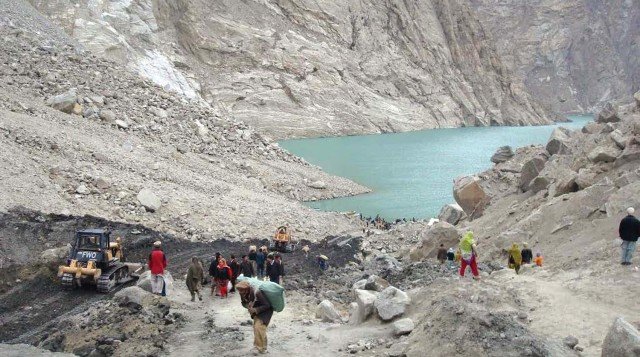
“On Friday, water discharge from the lake at Ganish Bridge, about 10 kilometres from Attabad, was approximately 4,800 cusecs and the inflow was also 4,800 cusecs,” the top administrator of Hunza said.
“So far the situation is normal, but we are monitoring the lake round-the-clock,” Deputy Commissioner Zafar Taj told The Express Tribune. He said that helicopters were conducting the surveillance operation.
Experts say that by the end of this month, inflow will exceed the 6,000-cusec mark as glaciers start melting due to rising temperatures.
Also on Friday, an official said that erosion has also increased and cracks have appeared in the spillway, indicating that it may collapse at any time.
However, Zamir Abbas, Assistant Commissioner of Hunza, said he hoped water flowing in the spillway would increase gradually because water was eating away banks of the spillway.
“Yes, if the outflow and inflow becomes equal, expansion of the lake will naturally stop,” he said, adding that if the outflow surpassed the inflow then water from the submerged villages would recede.
Five upstream villages are currently underwater. And hundreds of their residents have been relocated to relief camps set up on higher grounds.
Abbas said the boat service has also been restored to enable people across the lake to interact with each other.
In the meanwhile, sporadic rains in Gilgit and Hunza forced pilots to ground their helicopters which have flown 316 sorties over the past two weeks, transporting 4,071 passengers and 60 tons of food, fuel and medicines. Officials say the service will restart on Saturday if weather becomes clear.
Published in the Express Tribune, June 5th, 2010.



1731570357-0/elon-musk-(1)1731570357-0-165x106.webp)
-(1)1717678110-0/Kendrick-(1)-(1)1717678110-0-165x106.webp)












COMMENTS (3)
Comments are moderated and generally will be posted if they are on-topic and not abusive.
For more information, please see our Comments FAQ